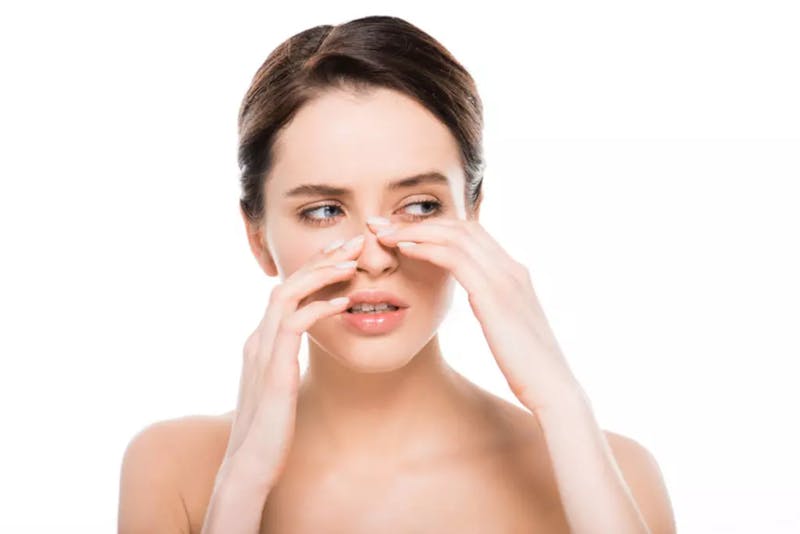
If you have sleep apnea and are considering rhinoplasty, you may be wondering about your safety, both during the procedure and recovery period. Having sleep apnea means that the muscles that support the soft tissues in your throat – such as the tongue and the palate – temporarily relax during sleep, effectively closing off your airway and interrupting your breathing.
Evidence suggests that certain physical traits, such as a displaced or deviated septum, can cause or worsen sleep apnea, so a rhinoplasty could significantly improve sleep quality. But, on the other hand, you may also be aware that surgery anesthesia during surgery can be dangerous for people with obstructive sleep apnea. So, is it safe to undergo rhinoplasty if you have sleep apnea, or should you avoid elective surgery?
How Does Rhinoplasty Improve Sleep Apnea?
People with sleep apnea temporarily stop breathing during their sleep cycle, which can lead to severe health issues like high blood pressure and heart attacks. In mild cases, sleep apnea can cause you to snore very loudly, wake up with headaches or a dry mouth, and experience excessive daytime sleepiness.
Treatment for sleep apnea usually involves using a special breathing device at night known as CPAP or continuous positive airway pressure machine. CPAP machines are highly effective and can be very necessary – even lifesaving – if you have moderate to severe sleep apnea. However, those with milder cases sometimes find the appliances cumbersome or uncomfortable, so they look for alternative solutions to their breathing issues.
Rhinoplasty, sometimes called a “nose job,” is a surgical procedure that changes the shape of the nose. Most people seek rhinoplasty for cosmetic reasons, such as making the nose smaller (or larger), changing its angle, reshaping its tip, narrowing the nostrils, or straightening the bridge (septum). But many others get it to improve breathing problems like sleep apnea and chronic sinusitis.
A crooked, off-centered, or bulbous nose doesn’t cause sleep apnea itself, but it can certainly exacerbate it and make breathing more difficult. So, during rhinoplasty, your surgeon can reshape your inner nasal structures to remove obstructions (like extra cartilage) to improve breathing. The procedure can be done to improve breathing concerns only, which is usually called functional rhinoplasty, or can be combined with cosmetic rhinoplasty to enhance and balance the appearance of your nose as well.
Considerations And Aftercare For People With Sleep Apnea
Facial surgeries like rhinoplasty are often performed under a combination of medications known as general anesthesia to keep you from feeling any pain or discomfort during the procedure. These medications tend to be very safe, but sleep apnea can make you more sensitive to their effects, which include slowing down your breathing and suppressing your cough reflex.
Since the pain medications you’re given can make it more difficult for you to wake up if you stop breathing, sleep apnea also puts you at greater risk for complications after surgery. These medicines also relax your throat muscles, potentially causing you to stop breathing more often. The good news is that these risks can be managed before, during, and after surgery with little preparation.
Unfortunately, more than half of patients with sleep apnea don’t know that they have it, so it’s important to talk to your primary doctor if you’ve been experiencing breathing issues at night – especially if you’re considering surgery. If you do know that you have it, it’s essential that you inform your surgical team before surgery so they can make all the necessary arrangements to keep you safe.
Depending on the severity of your breathing disorder, your doctor may ask you to wear your CPAP device every night for two to four weeks before the procedure. Prior to surgery, you will also get to speak with your day-of-surgery anesthesiologist, who might provide additional pre-op and post-op instructions to minimize risks.
If you regularly use a CPAP machine, your surgical team will likely ask you to bring it with you on the day of the procedure; often, sleep apnea patients are kept intubated until they are fully awake or put on their CPAP machines immediately after the intervention to support breathing. Finally, although rhinoplasty tends to be an outpatient procedure, your doctor may also have you stay at the hospital for a night or two for close monitoring and breathing support.
Once you are home from nose surgery, you should continue wearing your CPAP machine every night, especially if you are taking pain medications that can depress normal breathing and make it harder to wake up. And it’s also important to follow any other postoperative instructions to maximize results, like avoiding strenuous exercise for 10 to 14 days following the procedure, not wearing reading or sunglasses for three to four weeks, and eating a healthy, fiber-rich diet to help with healing.
More Questions About Rhinoplasty For People With Sleep Apnea?
Like all surgery, undergoing rhinoplasty when you have sleep apnea is not without its risks, but being forthcoming with your doctor about any breathing issues you might have can make the entire process safer. Rhinoplasty Denver is a primary focus of Dr. Thompson, who has dedicated his career to creating beautiful, functional results for his patients. For more information about functional or cosmetic rhinoplasty in people with sleep apnea, or to schedule a consultation with Dr. Thompson, please call our Denver office at (303) 667-1474 or click here.

